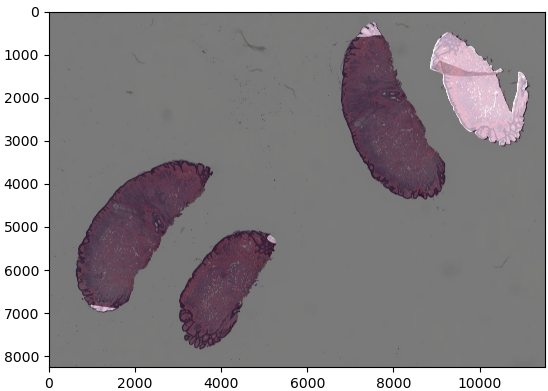 NA-MIC Project Weeks
NA-MIC Project Weeks
Back to Projects List
DICOM Structured Reports for WSI and conversion to segmentation object
Key Investigators
- Maximilian Fischer (DKFZ, Germany)
- Philipp Schader (DKFZ, Germany)
- Marco Nolden (DKFZ, Germany)
- Daniela Schacherer (Fraunhofer MEVIS, Germany)
- David Clunie (PixelMed, USA)
- Andrey Fedorov (BWH, USA)
- Chris Bridge (MGH, USA)
- Klaus Maier-Hein (DKFZ, Germany)
Project Description
In this project, we want to investigate and compare several approaches to convert DICOM Structured reports into DICOM segmentation objects. We use the integrated SLIM Viewer in Kaapana to create Structured Reports on DICOM WSI files and also want to compare the QuPath viewer as additional DICOM WSI viewer in Kaapana.
Objective
- Objective A: Examine existing libraries to render the coordinates from the SR file as segmentation.
- Objective B: Examine conversion methods to create DICOM annotation objects from the SR files
- Objective C: Evaluate file formats of QuPath DICOM WSI annotations.
- Objective D: Explore integration capabilities of QuPath as Viewer in Kaapana
Approach and Plan
- Familiarize with the highdicom librariy
- Compare result with custom visulaizations
- Evaluate conversion tools for SR files
- Test PACS connectivity of QuPath
Progress and Next Steps
- Familiarized with the highdicom library for accessing the SR coordinates
- Switching to a more generic way for rendering the coordinates
for i in range(AnnotatetObjects3): Type=FileFull.ContentSequence[13].ContentSequence[i].ContentSequence[2].ConceptCodeSequence[0].CodeMeaning Coords3=FileFull.ContentSequence[13].ContentSequence[i].ContentSequence[3].GraphicData x_coords3 = [int((Coords3[i]-Origin_X)/spacing_x) for i in range(0, len(Coords3), 3)] y_coords3 = [int((Coords3[i]-Origin_Y)/spacing_y) for i in range(1, len(Coords3), 3)] if Type=='Tissue': tissue_list.append([x_coords3,y_coords3]) color=(255,0,0) else: tumor_list.append([x_coords3,y_coords3]) color=(0,0,255) contours = np.array([[[abs(x), abs(y)] for x, y in zip(x_coords3, y_coords3)]], dtype=np.int32).
sr = hd.sr.srread("/Users/maximilianfischer/ProjectsMountDir/CMU-1/Consistent/SR/DICOM/1E447C90/E88940CE/4E17833F.dcm") groups = sr.content.get_planar_roi_measurement_groups() groups[0].roi groups[0].roi.value coords=[] for x in range(groups[0].roi.value.shape[0]): coords.append([groups[0].roi.value[x][0],groups[0].roi.value[x][1]])Much shorter code!
- Rendering still done with opencv, but planning to switch to rasterio.
- Bioformats as new DICOM conversion library to be supported in Kaapana (currently mostly based on PixelMed.)
Illustrations

No response
Background and References
This project is the continuation from last years project weeks. PW 38 PW 39 Kaapana